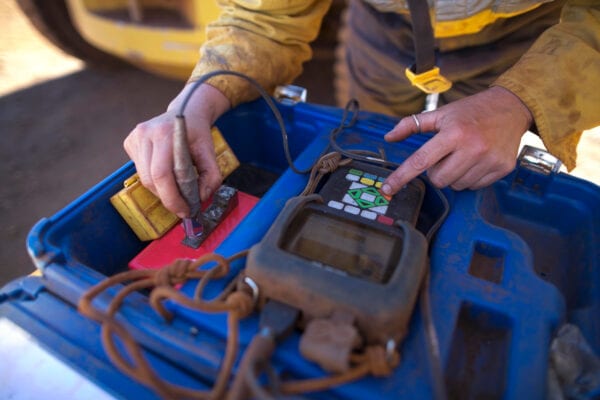Maintenance departments in every industry from manufacturing to facilities utilize several types of maintenance to create a complete maintenance strategy. Learning about the different types of maintenance can help you can make informed decisions. This includes how to minimize downtime and get the longest lifespan possible out of your equipment and facility assets.
In this article, we will discuss the 4 most common types of maintenance including when each should be performed, what benefits each type of maintenance provides, and how you can implement each type of maintenance at your facility. To compare these types of maintenance to a real-life scenario, we’re going to use a simple analogy of a pot of water on the stove.
4 Types of Maintenance
Maintenance activities are typically broken down into 4 types of maintenance: corrective maintenance (CM), preventive maintenance (PM), condition-based maintenance (CbM), and predictive maintenance (PdM). Each type of maintenance is described in its own section below.
Corrective Maintenance (CM)
Corrective maintenance, or CM, is defined as a maintenance task performed to restore a non- or under-performing asset to an optimum or operational condition. One way maintenance teams use corrective maintenance is to allow assets to fail before repairing or replacing them because it is cost and labor effective to do so. It can be a simple maintenance method to carry out, and is also referred to as reactive maintenance.

Read more in this blog post: What is Corrective Maintenance?
Corrective maintenance compares to waiting until the pot of water has begun to boil over before taking action. When you notice the water overflowing, you would turn off the burner, remove the pot from the burner, and wipe up the hot water before returning the pot to the burner. You would likely watch the water more closely to prevent it from boiling over again.
When to Use Corrective Maintenance
Corrective maintenance might be the best approach to maintaining smaller assets, in which preventive maintenance costs more than replacing the asset entirely. The decision about when to do corrective maintenance may also come about based on a costs-benefit analysis. If a 5 or 10 horsepower motor breaks down, it would likely be more cost efficient to replace it than make a repair. Purchasing and installing new parts, paying for labor, and the downtime during the repair would likely cost more than buying a new motor.
Corrective maintenance is not limited to equipment assets. For example, organizations performing facility maintenance such as cutting the grass are performing corrective maintenance. They are correcting an undesirable state (the grass being too long), which at minimum, would need to be done before the length violates city ordinance.
Oftentimes, corrective maintenance is chosen as part of a deliberate run-to-failure strategy. One example of corrective maintenance which should be done only after failure is replacing a burned out light fixture in a stadium. The facility’s maintenance team would wait until multiple lights fail rather than replacing just one at a time. It would be a waste of money to try to predict when each light would fail, or to replace each one before it fails. The consequence of running these lights to failure is low. However, the light bulbs need to be replaced before the number of burned out bulbs causes a potential safety or visibility issue.
Benefits of Corrective Maintenance
Even though it is reactive in nature, there are some benefits and advantages of corrective maintenance, such as it:
- Saves money by helping you decide to replace assets when it’s most cost effective
- Costs less to plan
- Simplifies process for the maintenance team
- Simplifies work delegation
- Can be done without software (although software is very beneficial for corrective maintenance)
How to Implement Corrective Maintenance
Out of all maintenance types, the implementation of corrective maintenance is the most commonly used and straight-forward. You can regularly perform unplanned corrective maintenance. That being said, there are different variations of corrective maintenance that come into play.
-
- Emergency Maintenance: This type of corrective maintenance includes failures that occur unexpectedly and are severe enough that they need to be addressed immediately.
- Breakdown Maintenance: This occurs after a non-critical asset totally breaks down. It should be attended to soon, but production can continue without it.
- Deferred Corrective Maintenance: This type of corrective maintenance includes repairs that were deferred, but need to be made to restore the function of an asset, although they are not as critical.
While corrective maintenance is likely already being done, there are ways you can implement more effective corrective maintenance. One way to increase corrective maintenance effectiveness is to provide a better way to be notified of maintenance needs. This can be achieved through a maintenance request system. A request system is often part of computerized maintenance management system (CMMS) software. Maintenance managers should train all asset users (inside and outside of the maintenance department) on how to properly describe the problem in a maintenance request.
Another tip that will help you more effectively carry out corrective maintenance is to create an organized method of filing the supporting materials technicians need to perform maintenance. These include user manuals, warranties, and troubleshooting guides, so that these are readily available when the maintenance work must be performed. You should also keep the necessary parts in stock to avoid the need for improvising solutions on the fly or having to wait for costly, expedited shipments of ordered parts.
Preventive Maintenance (PM)
Preventive maintenance, or PM, is maintenance that is proactively performed on an asset with the goal of lessening the likelihood of failure, reducing unexpected downtime, and prolonging its useful life. Preventive maintenance is much more complex than corrective maintenance.

Learn More: What is Preventive Maintenance?
To describe preventive maintenance using our pot of water analogy again, you would do things to prevent the water from boiling over: using slightly less water or a bigger pot, turning the burner down from high to medium-high so that it takes longer to boil, and remembering the time it took for the water to boil over last time; then subtracting a few minutes from that so your water does not reach the boil over point.
When to Use Preventive Maintenance
Organizations seek to implement preventive maintenance because they want to reduce the corrective maintenance they have to do. They may feel overwhelmed with repairs and asset downtime to the point where the team can’t keep up. Maintenance teams decide to use preventive maintenance when they want to prevent total failure of large scale assets. While the number of maintenance tasks is nearly endless, some examples of preventive maintenance include:
- Inspections
- Fluid replacement
- Lubrication
- Small parts replacement (air filter, hose clamps, etc).
When to apply preventive maintenance depends largely on when it can be used in conjunction with effective corrective maintenance. When you can’t keep up with all of the repairs, implementing preventive maintenance program will reduce the number of asset failures and save time. You will be able to focus on reducing machine downtime and increasing your production rate through preventive maintenance, which will lead to greater asset availability.
Preventive maintenance should be used to prevent critical and/or expensive assets from failing. It should be done when you are able to balance smaller, less critical PM tasks with larger corrective maintenance tasks. Ideally, preventive maintenance should be a continuous strategy that reduces the need for corrective maintenance as much as possible.
Benefits of Preventive Maintenance
There are a number of benefits of preventive maintenance, although it may take time for you to reap those benefits. They can’t be seen overnight, but in the long run, they are significant. Preventive maintenance:
- Improves workplace safety
- Increases the lifespan of machines or condition of the facility
- Reduces downtime
- Ensures a higher production rate
- Helps you gain insights into assets and how to maintain them (when done with CMMS software)
How to Implement Preventive Maintenance
A schedule to maintain assets before failure must be developed along with planning for part restocking and labor. Once your maintenance department coordinates all of the resources required to optimize preventive maintenance, implementing it is fairly straightforward.
A preventive maintenance program can start with carrying out a few simple PM tasks, such as replacing a filter or performing a regular inspection on an asset. While you don’t need software or a complicated schedule to perform basic preventive maintenance, it is easier to track with maintenance management software.
Rest assured that once you develop a preventive maintenance strategy and use the right tools, the program can be painless. Preventive maintenance requires some effort, but ultimately lowers maintenance costs. While an entire blog post could be written on this topic alone, here are some quick tips for implementing preventive maintenance:
- Create a plan and decide who will be involved in the PM program
- Make sure you have the resources (employees, parts, and tools) available to carry out preventive maintenance
- Inventory your facility’s equipment and other assets
- Determine which assets are critical to production and prioritize preventing failure of these assets
- Create standardized PM processes and procedures
- Prioritize recurring PM tasks
Implementing preventive maintenance is best done with the help of computerized maintenance management system (CMMS) software. CMMS software has the capability to schedule PM work orders in advance, apply work order templates to reoccurring work orders, associate tasks and parts with multiple frequencies, and reschedule work orders quickly as needed.
In addition to CMMS software, you’ll also need to train your technicians on implementing preventive maintenance. This includes not only learning how to use the software, but also what expectations maintenance managers have in terms of daily routines. There may be some new tasks that technicians must be trained on how to do because they have never been done before.
Condition-based Maintenance (CbM)
Condition-based maintenance, or CbM, is another form of preventive maintenance, but it is performed closer to failure than traditional preventive maintenance. Condition-based maintenance is a strategy in which you wait until an asset is exhibiting measurable symptoms that indicate that failure is nearing or more probable. It is defined as a reactive maintenance technique that uses real-time data (collected through sensors) to identify when an asset’s performance or condition reaches a level where failure is nearing or more probable.
In most instances, the difference between predictive maintenance and condition-based maintenance is small.

Read More: What is Condition-based Maintenance?
Now we’re going to think of our pot of water in terms of condition-based maintenance. You would monitor the temperature of the water so that it doesn’t boil over, then add your food or adjust the burner settings before the water spills. That is a very simplified example of condition-based maintenance in this analogy.
When to Use Condition-based Maintenance
Condition-based maintenance ensures that you perform maintenance when the condition of the asset warrants it—not before, not after. Think of it as a “just in time” type of maintenance. Condition-based maintenance is meant to be done when conditions that are monitored reach a specified level. It uses real-time data to optimize and prioritize maintenance resources and prioritize them. Just a few examples of condition-based maintenance include monitoring temperature and pressure, as well as oil and vibration levels.
So, what considerations should be taken before using condition-based maintenance in your overall maintenance strategy? First, you need to invest in equipment to measure asset conditions and ensure maintenance technicians know how to use this equipment. Keep in mind that this part of the condition-based maintenance strategy can be costly, but will pay off in the long run.
Once you have the tools you need to begin analyzing data, this data must be used to build insights that are actionable. It’s also a good time to brush up on any regulations that apply to your processes or machines since they change rapidly. Inadvertently violating a regulation can hinder the most well intended maintenance plans.
Benefits of Condition-based Maintenance
There are many benefits of condition-based maintenance, which can be easily summarized here:
- Costs less than other types of maintenance
- Improves asset reliability
- Reduces unplanned failures
- Prevents unnecessary maintenance tasks from being performed
- Conserves parts
- Saves on labor costs
- Can be completed when assets are operating, resulting in no downtime
How to Implement Condition-based Maintenance
To carry out condition-based maintenance, you must complete multiple steps including capturing sensor data, communicating the data, analyzing the data to determine when and where maintenance should be performed, creating and scheduling maintenance work orders, and performing maintenance work. Condition-based monitoring performs non-destructive testing through sensors.
Once these sensors perform the tests, they communicate the data (or parameters that indicate maintenance is needed) to employees. This can be done through a programmable logic controller (PLC), human machine interface (HMI), or SCADA system. After the maintenance team is notified of maintenance that needs to be done, they need to carry out maintenance tasks.
Maintenance management software such as a CMMS system makes the implementation of condition-based maintenance considerably easier to track. You can document work from a condition-based maintenance program in CMMS software. The asset management features within the software allow you to view service history to assist in troubleshooting. You can also use reports to compare data about monitoring asset health.
Predictive Maintenance (PdM)
Predictive maintenance, or PdM, is a proactive maintenance technique that uses real-time asset data (collected manually or through sensors), historical performance data, and advanced analytics to forecast when asset failure will occur. Predictive maintenance is a sophisticated form of preventive maintenance that is used by organizations with a robust maintenance program.

Our pot of water analogy may be a bit too simple for predictive maintenance, but it can still be applied. You would take data from past experiences (time it took for water to boil, variations in boil time depending on amount of water and type of food being cooked, and what the best burner setting to boil water is). This data would be used to create a procedure for boiling water the fastest, safest way without ruining your stove top or overcooking your food.
Read More: What is Predictive Maintenance?
When to Use Predictive Maintenance
While the circumstances in which it is appropriate to use predictive maintenance varies for every organization, there are some things to keep in mind to help you decide when to carry out predictive maintenance. Before you carry out predictive maintenance work, you should go through this process:
- Determine the conditional standards required for your predictive maintenance needs
- Install tools and processes for monitoring
- Create the automatic triggers needed to indicate failure or that maintenance should be done
- Collect the data you need and monitor it
- Create work order when the indicated conditions for maintenance or failure are met
- Perform the maintenance (any type needed)
As you probably gathered, this process is repeated as often and as with many assets as needed.
To better help you understand when you should use predictive maintenance, let’s go over a few examples of how and when it is used. Companies in the power and energy industry may use predictive maintenance to prevent disruptive, costly outages. Transportation companies, especially railway systems, use predictive maintenance through the Internet of Things (IoT) to predict failure and perform maintenance before these failures become safety issues. Manufacturing plants use infrared technology as part of predictive maintenance to detect overheating of machinery.
Benefits of Predictive Maintenance
There are several benefits of predictive maintenance for organizations which increase when a predictive maintenance program has been in place for some time.
- Saves money, as predictive maintenance takes less time and is less expensive
- Reduces loss of production hours, spare parts, and maintenance supplies
- Predicts asset failure mode with regular monitoring in a cost effective way
- Reduces corrective maintenance
- Gives you a real-time overview of your assets’ condition
- Ensures minimal and predictable production interruption
- Yields the highest Return on Investment (ROI) out of all maintenance types
How to Implement Predictive Maintenance
This is one of the most advanced types of maintenance, so it should be implemented when your maintenance team has a good handle on other maintenance types. In order to implement predictive maintenance, you need go through several steps:
- Identify assets appropriate for predictive maintenance
- Confirm adequate technical infrastructure to support the PdM program
- Determine the conditions that monitoring will allow prediction of future asset failure
- Decide what sensors will be used to monitor conditions
- Install the sensors
- Allocate resources for completing PdM tasks
- Train employees on how to interpret data
- Collect and analyze data, detect faults, and predict time to failure
- Calculate and set best maintenance schedule to cost-effectively prevent asset failure
Doing all of this is easier when you have data acquisition software that can be integrated with a CMMS system. Values from predictive maintenance software can be transferred into a CMMS system, and work orders can be automatically generated by the CMMS software. Predictive maintenance testing is done automatically by sensors on each machine (or by manual observation), and the results can be recorded in CMMS software as part of asset history. Maintenance reports can also be generated to compare results of various predictive maintenance analyses.
FTMaintenance Facilitates All Types of Maintenance
FTMaintenance is a CMMS software system that can be used for any type of maintenance program. Schedule a demo today to see FTMaintenance in action.















Recent Comments